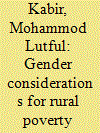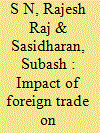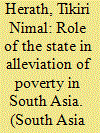|
|
|
Sort Order |
|
|
|
Items / Page
|
|
|
|
|
|
|
| Srl | Item |
| 1 |
ID:
141343


|
|
|
|
|
| Summary/Abstract |
The Gini Index suggests that income inequality is a highly prevalent phenomenon in Southeast Asia (The World Bank, 2012a). As Zaman and Akita (2012) points out, differentials in income is especially prominent in Bangladesh. Our article investigates which factors create differentials in income in Bangladesh. Using data from the Household Income Expenditure Survey published by the Bangladesh Bureau of Statistics, we estimated two separate models—one for daily wage and one for annual salary. We found that education, age (which was used as a proxy for labour market experience), gender and place of work significantly brought about differentials in daily wage rates. We also observed that all four of the above variables, along with different types of occupations, caused differentials in annual salary. We conclude by making several policy recommendations to address these findings.
|
|
|
|
|
|
|
|
|
|
|
|
|
|
|
|
| 2 |
ID:
141342


|
|
|
|
|
| Summary/Abstract |
Anti-dumping as a new protectionist trade policy has evolved as the popular strategy choice for the trading nations. Since the Uruguay Round of World Trade Organization (WTO) (1994), India has been a prominent user of it. This article attempts to explore the possible factors that might have triggered off 90 percent cases of anti-dumping by five major Indian manufacturing industries over the period 1997–2011. We construct a balanced panel combining data on anti-dumping initiations from the ‘Global Antidumping Database’ with trade data from the Directorate General of Commercial Intelligence and Statistics (DGCI&S)-India and United Nations Comtrade database at the Indian Trade Classification (ITC) based on Harmonized System (HS) two-digit level. Having count data, the empirical model is estimated initially through a random-effects Poisson regression model followed by a negative binomial model. The number of anti-dumping initiations in India is dependent on the value of imports, the presence of a dominant industry lobby and the retaliatory behaviour by the affected domestic firms, among some others. In fact, we find that in determining the number of anti-dumping initiations the conventional economic and foreign affairs policies take a backseat!
|
|
|
|
|
|
|
|
|
|
|
|
|
|
|
|
| 3 |
ID:
141340


|
|
|
|
|
| Summary/Abstract |
Foreign direct investment (FDI) can play a significant role in achieving rapid economic growth in developing countries such as Sri Lanka. Even after the 30-year-long war that ended in 2009, the economy is still struggling to convince domestic and foreign investors that Sri Lanka is ‘ready for business’. In the light of this situation, identifying the factors that could influence FDI inflows into Sri Lanka is crucial to design policies aimed at attracting more FDI. This article empirically investigates the determinants of FDI inflows into Sri Lanka using annual data for the period 1978–2013 and applying the latest econometric techniques in time series analysis. As expected, market size, trade openness and infrastructure level have a positive impact, while wage and political instability have a negative impact on FDI. From a policy point of view, the results suggest that, to attract FDI inflows, Sri Lanka should develop and introduce policies that would improve the level of market size, trade openness, infrastructure and political stability but reduce the cost of labour.
|
|
|
|
|
|
|
|
|
|
|
|
|
|
|
|
| 4 |
ID:
141344


|
|
|
|
|
| Summary/Abstract |
UNICEF (2010), ADB (2011) and GOB (2011) reports reveal that Bangladesh has made significant progress in its social development areas; however, it still lack behind to eradicate poverty and sustain its social development. An initiative, rural non-farm economy (RNFE), has been introduced in Bangladesh to address poverty, social development and to empower rural women financially. RNFE has made contribution to match male–female parity in work participation and also to attain economic empowerment for women by enabling them to engage in economic activities without violating the social norms. The study indicates that women RNFE participants should get more income support and better health care facilities to maintain their subsistence and to get rid of poverty, while men RNFE participants should get more support to get involved in high-income RNFE activities and promote RNFE income growth.
|
|
|
|
|
|
|
|
|
|
|
|
|
|
|
|
| 5 |
ID:
141339


|
|
|
|
|
| Summary/Abstract |
This study attempts to investigate the impact of international trade on the manufacturing employment and wages in India over the period 1980–2005. Given India’s abundant labour force, the empirical evidence will provide an indication on the role of trade openness in labour market in terms of employment and wages. We employ three standard modelling approaches, namely, factor content, growth decomposition and panel data modelling approaches, to verify the role of trade on employment and wages. We use panel data at the industry level obtained from Annual Survey of Industries (ASI) and World Bank trade data set. Our results suggest that international trade has not had any significant impact on employment generation in the manufacturing sector in India. While there is little evidence on any significant effect of export orientation on employment, import penetration had a detrimental effect on employment generation.
|
|
|
|
|
|
|
|
|
|
|
|
|
|
|
|
| 6 |
ID:
141341


|
|
|
|
|
| Summary/Abstract |
The market and the state have to play valuable complementary roles in economic development. The government or state is expected to correct and facilitate the market. If the government fails, people cannot lead fine lives. At present, South Asian people have many socio-economic and political problems including poverty. Some of these problems are outcomes of poor performance of the state and are correlated with poverty. Specifically speaking, in South Asia, 32 per cent of the population lives on less than $1.25 a day. Some countries do not concentrate on development. Instead, they are entangled in civil struggles, infringement of human rights and failures of government, such as, corruption. Therefore, this study examines whether the South Asian countries have played the proper role of the state as accepted by economists. This objective is achieved by analyzing selected performance measures of the state, such as, corruption, rule of law, modernization of roads, education, health and governance, over time and comparing their changing patterns between economies. The study is based on secondary data, and in addition to qualitative analysis, many variables are econometrically analyzed. It concludes that in South Asian states poverty is decreasing but states and governments of these countries have to do much more to promote growth and alleviate poverty.
|
|
|
|
|
|
|
|
|
|
|
|
|
|
|
|
| 7 |
ID:
141338


|
|
|
|
|
| Summary/Abstract |
Entering and surviving in export markets is a costly process that involves learning about the existence of foreign demand, ‘discovering’ production costs, building up reputation, succeeding in product branding to reduce competitive pressures and to upgrade quality to serve demanding international clients, and remaining competitive in the marketplace. This article argues that tourism alleviates some of these costs by providing an inexpensive platform for cost discovery and by acting as an accessible ‘in-house’ trade fair for domestic producers. It combines product-level data on world and Nepal’s exports with Nepalese data on tourist inflows, and macro-indicators on relative prices. For tourism-related goods, it reveals a positive association between tourist inflows from given destinations with future merchandise exports to those destinations, while no association is found for goods unrelated to tourism. The results suggest spillovers from tourism into merchandise export performance and diversification and gains from cooperation between tourism and export promotion.
|
|
|
|
|
|
|
|
|
|
|
|
|
|
|
|
|
|
|
|
|